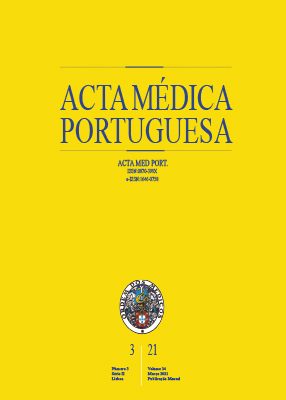Early Detection of COVID-19 in Portugal: Use of Clinical Records
DOI:
https://doi.org/10.20344/amp.14593Keywords:
COVID-19, Coronavirus Infections/diagnosis, Pneumonia, Viral/diagnosis, Portugal, SARS-CoV-2, Sentinel SurveillanceAbstract
Introduction: Syndromic surveillance allows early detection of changes in the population’s morbidity pattern. The aim of this study is to evaluate the usefulness of indicators related to access to healthcare services, in COVID-19 surveillance.
Material and Methods: A time series analysis was performed using the weekly incidence rate of COVID-19 in Mainland Portugal, between weeks 14/2020 (March 30 to April 5) and 25/2020 (June 15 to 21), and six indicators: 1) COVID-19 consultations in primary healthcare; 2) number of COVID-19 emergency department visits; 3) number of emergency department visits due to viral pneumonia; 4) number of hospitalizations due to viral pneumonia; 5) proportion of emergency department visits due to viral pneumonia; and 6) proportion of hospitalizations for viral pneumonia. Pearson correlation and cross-correlations were computed.
Results: A strong correlation was found between the weekly incidence rate of COVID-19 and all indicators. [(1) 0.76; (2) 0.82; (3) 0.77; (4) 0.84; (5) 0.86; e (6) 0.90]. Emergency department visits and hospitalizations for viral pneumonia detect variations in the frequency of the disease with a one week lag compared to the incidence rate of COVID-19, in one week. COVID-19 consultations in primary healthcare and emergency department visits trail behind the incidence rate of COVID-19, in one week. The proportion of viral pneumonias in emergency department visits, or hospitalizations, is temporally aligned with the weekly incidence rate of COVID-19.
Discussion: The delay found in the COVID-19 primary healthcare consultations and emergency department visits, may be related to changes in access to healthcare services and clinical coding. Emergency department visits and hospitalizations for viral pneumonia may be useful in the early detection of COVID-19. Viral pneumonia may have been coded as being of unknown origin. Future monitoring of these indicators is necessary to ascertain whether the incidence of COVID-19 is significantly influenced by changes in testing strategies. The indicators described in this study will be an asset for the optimization of testing strategies, allocation of healthcare resources to the communities that are most vulnerable to severe morbidity and assessing vaccination impact. As such, surveillance systems based on clinical data will be a valuable complementary tool to SINAVE.
Conclusion: The indicators under analysis could be used regularly, with special attention to viral pneumonias, to detect outbreaks of COVID-19. Information on pneumonia of unknown etiology may be considered in the surveillance of COVID-19.
Downloads
Downloads
Published
How to Cite
Issue
Section
License
All the articles published in the AMP are open access and comply with the requirements of funding agencies or academic institutions. The AMP is governed by the terms of the Creative Commons ‘Attribution – Non-Commercial Use - (CC-BY-NC)’ license, regarding the use by third parties.
It is the author’s responsibility to obtain approval for the reproduction of figures, tables, etc. from other publications.
Upon acceptance of an article for publication, the authors will be asked to complete the ICMJE “Copyright Liability and Copyright Sharing Statement “(http://www.actamedicaportuguesa.com/info/AMP-NormasPublicacao.pdf) and the “Declaration of Potential Conflicts of Interest” (http:// www.icmje.org/conflicts-of-interest). An e-mail will be sent to the corresponding author to acknowledge receipt of the manuscript.
After publication, the authors are authorised to make their articles available in repositories of their institutions of origin, as long as they always mention where they were published and according to the Creative Commons license.









